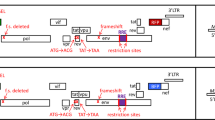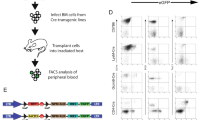Abstract
Retroviral vector-mediated expression of the homeoboxgene, HoxB4, in hematopoietic cells has been reported to mediate a benign expansion of gene-modified hematopoietic stem and precursor cells in vivo. In the present study, we used a novel coexpression strategy for coordinated expression of HoxB4 along with a cytoplasmic protein from a retroviral vector. The novel coexpression strategy, based on cotranslational protein separation mediated by the 2A sequence of foot-and-mouth disease virus (FMDV), allows an indirect quantification of HoxB4 expression levels when inserting a reporter such as the enhanced green fluorescent protein (GFP) in the retroviral vector. Presence of the 2A sequence did not interfere with the correct subcellular localization of HoxB4 (nuclear) and GFP (cytoplasmic), nor with the titer of bicistronic vectors, and mediated functional long-term coexpression (at least 1 year) of GFP and HoxB4 after transplantation of transduced mouse bone marrow cells in mice.
This is a preview of subscription content, access via your institution
Access options
Subscribe to this journal
Receive 12 print issues and online access
$259.00 per year
only $21.58 per issue
Buy this article
- Purchase on Springer Link
- Instant access to full article PDF
Prices may be subject to local taxes which are calculated during checkout





Similar content being viewed by others
References
Sauvageau G et al. Overexpression of HOXB4 in hematopoietic cells causes the selective expansion of more primitive populations in vitro and in vivo Genes Dev 1995 9: 1753–1765
Thornsteindottir U, Sauvageau G, Humphries RK . Enhanced in vivo regenerative potential of HoxB4-transduced hematopoietic stem cells with regulation of their pool size Blood 1999 8: 2605–2612
van Oostveen J et al. The role of homeobox genes in normal hematopoiesis and hematological malignancies Leukemia 1999 13: 1675–1690
Krosl J et al. Cellular proliferation and transformation induced by HOXB4 and HOXB3 proteins involves cooperation with PBX1 Oncogene 1998 16: 3403–3412
Krosl J, Sauvageau G . AP-1 complex is effector of Hox-induced cellular proliferation and transformation Oncogene 2000 19: 5134–5141
Beslu N et al. The N-terminal amino acids 31–100 and the homeodomain delineate regions of HOXb4 involved in HSC expansion Blood 2000 96: 496a (Abstr. 2135)
Emerman M, Temin HM . Genes with promoters in retrovirus vectors can be independently suppressed by an epigenetic mechanism Cell 1984 39: 449–467
Borman AM, Le Mercier P, Girard M, Kean KM . Comparison of picornaviral IRES-driven internal initiation of translation in cultured cells of different origins Nucleic Acids Res 1997 25: 925–932
Belsham GJ, Sonenberg N . RNA–protein interactions in regulation of picornavirus RNA translation Microbiol Rev 1996 60: 499–511
Sommergruber W et al. Polypeptide 2A of human rhinovirus type 2: identification as a protease and characterization by mutational analysis Virology 1989 169: 68–77
Toyoda H et al. A second virus-encoded proteinase involved in proteolytic processing of poliovirus polyprotein Cell 1986 45: 761–770
Ryan MD et al. A model for non-stoichiometric, co-translational protein scission in eukaryotic ribosomes Bioorganic Chem 1999 27: 55–79
Donelly LLD et al. The cleavage activities of aphtovirus and cardiovirus 2A proteins J Gen Virol 1997 78: 13–21
Ryan MD, Drew J . Foot-and-mouth disease virus 2A oligopeptide mediated cleavage of an artificial polyprotein EMBO J 1994 134: 928–933
Percy N, Barclay WS, Garcia-Sastre A, Palese P . Expression of a foreign protein by influenza A virus J Virol 1994 68: 4486–4492
Schmidt M, Rethwilm A . Replicating foamy virus-based vectors directing high level expression of foreign genes Virology 1995 210: 167–178
de Felipe P et al. Use of the 2A sequence from foot-and-mouth disease virus in the generation of retroviral vectors for gene therapy Gene Therapy 1999 6: 198–208
de Felipe P, Izquierdo M . Tricistronic and tetracistronic retroviral vectors for gene transfer Hum Gen Ther 2000 11: 1921–1931
Borman AM, Bailly J-L, Girard M, Kean KM . Picornavirus internal ribosomal entry segments: comparison of translation efficiency and the requirements for optimal internal initiation of translation in vitro Nucleic Acids Res 1995 23: 3656–3663
Ziegler E et al. Foot-and-mouth disease virus Lb proteinase can stimulate rhinovirus and enterovirus IRES-driven translation and cleave several proteins of cellular and viral origin J Virol 1995 69: 3465–3474
de Quinto LS, Martinez-Salas E . Involvement of the aphtovirus RNA region located between the two functional AUGs in start codon selection Virology 1999 255: 324–336
Fehse B et al. CD34 splice variant: an attractive marker for selection of gene-modified cells Mol Ther 2000 1: 448–456
Cavazzana-Calvo M et al. Gene therapy of human severe combined immunodeficiency (SCID)-X1 disease Science 2000 288: 669–672
Abonour R et al. Efficient retrovirus-mediated transfer of the multidrug resistance 1 gene into autologous human long-term repopulating hematopoietic stem cells Nat Med 2000 6: 652–658
Malech HL et al. Prolonged production of NADPH oxidase-corrected granulocytes after gene therapy of chronic granulomatous disease Proc Natl Acad Sci USA 1997 94: 12133–12138
Chu P, Lutzko C, Stewart AK, Dube ID . Retrovirus-mediated gene transfer intro human hematopoietic stem cells J Mol Med 1998 76: 184–192
Ramesh N et al. High-titer bicistronic retroviral vectors employing foot-and-mouth disease virus internal ribosome entry site Nucleic Acids Res 1996 24: 2697–2700
Grez M, Akgun E, Hilberg F, Ostertag W . Embryonic stem cell virus, a recombinant murine retrovirus with expression in embryonic stem cells Proc Natl Acad Sci USA 1990 87: 9202–9206
Ausubel F et al. Current Protocols in Molecular Biology John Wiley & Sons: New York 1998
Harlow E, Lane D . Antibodies – A Laboratory Manual Cold Spring Harbor Laboratories: New York 1988 pp 367–419
Gouilleux F, Wakao H, Mundt M, Groner B . Prolactin induces phosphorylation of Tyr694 of Stat5 (MGF), a prerequisite for DNA binding and induction of transcription EMBO J 1994 13: 4361–4369
Acknowledgements
This work was supported by the ‘Bundesministerium für Bildung und Forschung’, BMBF 01KV9811 and BMBF 5008410. We thank Cordula Gruettner and Goekhan Arman-Kalcek for excellent technical assistance. We are also grateful to Keith Humphries and Michael Niepmann for providing us with the cDNAs of human HoxB4 and the FMDV-OK1 IRES, respectively.
Author information
Authors and Affiliations
Rights and permissions
About this article
Cite this article
Klump, H., Schiedlmeier, B., Vogt, B. et al. Retroviral vector-mediated expression of HoxB4 in hematopoietic cells using a novel coexpression strategy. Gene Ther 8, 811–817 (2001). https://doi.org/10.1038/sj.gt.3301447
Received:
Accepted:
Published:
Issue Date:
DOI: https://doi.org/10.1038/sj.gt.3301447
Keywords
This article is cited by
-
CAR-T cell potency: from structural elements to vector backbone components
Biomarker Research (2022)
-
Optimisation of the foot-and-mouth disease virus 2A co-expression system for biomedical applications
BMC Biotechnology (2013)
-
Successful Treatment of Metachromatic Leukodystrophy Using Bone Marrow Transplantation of HoxB4 Overexpressing Cells
Molecular Therapy (2010)
-
Signed outside: a surface marker system for transgenic cytoplasmic proteins
Gene Therapy (2010)
-
Generation of a stable mammalian cell line for simultaneous expression of multiple genes by using 2A peptide-based lentiviral vector
Biotechnology Letters (2009)



